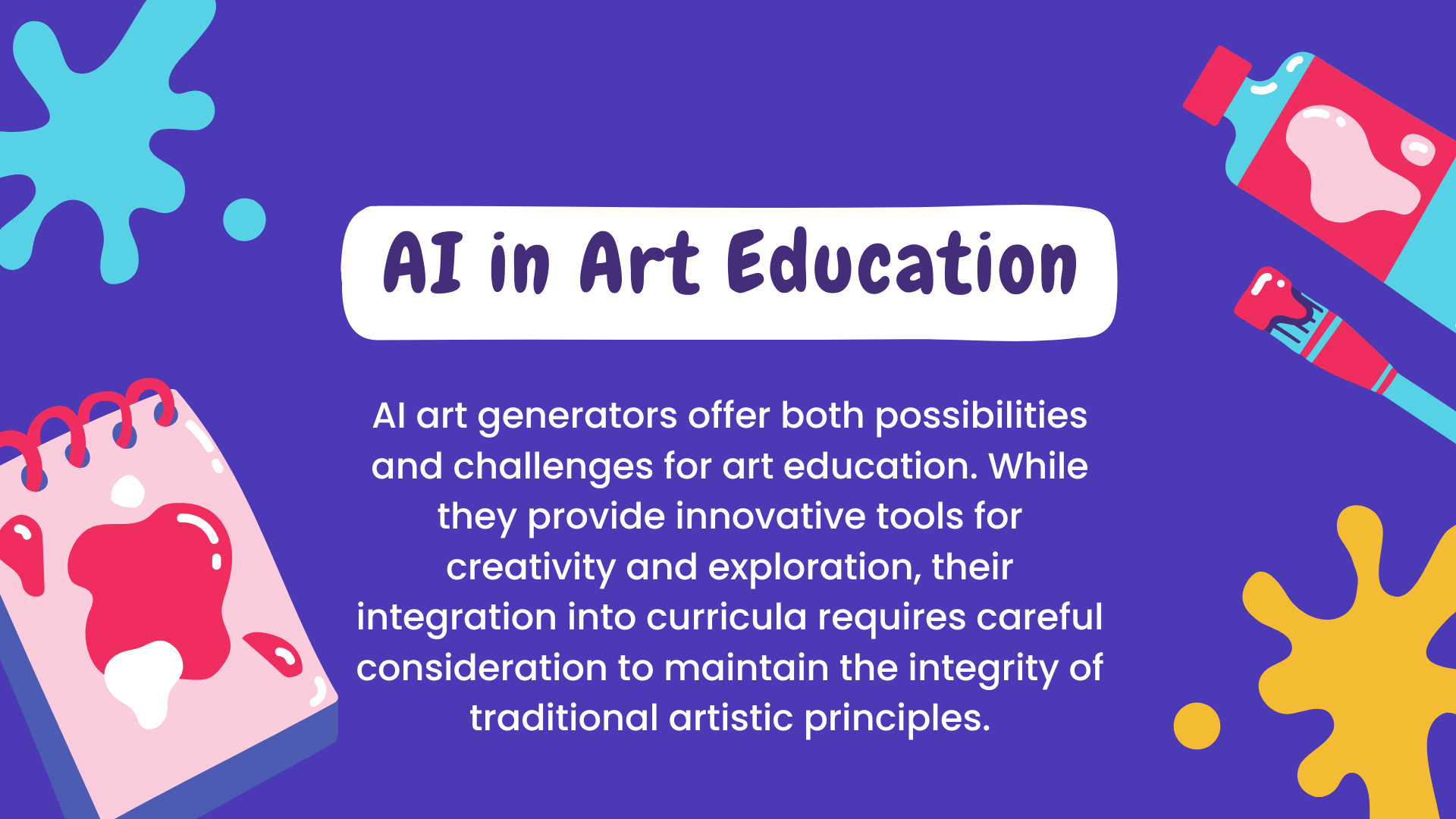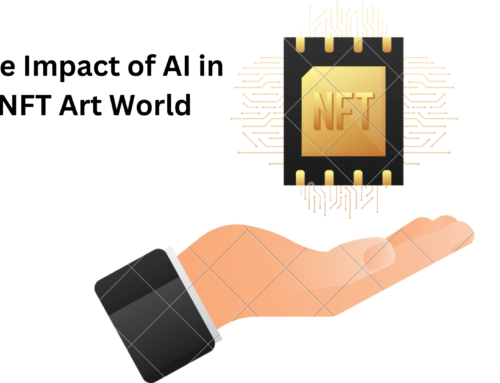You might have heard about AI, or Artificial Intelligence, making waves in various fields, but did you know it’s shaking up the world of art too? Yeah, that’s right! AI technology is getting creative, and it’s starting to influence how we teach and learn art. Unveil the transformative potential of AI art’s impact on art education, reshaping the creative landscape with innovative approaches.

How might the emergence of AI art generators influence art education and curriculum?
Imagine you’re in art class, and instead of just learning about paintbrushes and canvases, you also get to play around with AI art generators. These are fancy computer programs that can create stunning artworks all on their own. It’s like having a digital Picasso or a virtual Van Gogh at your fingertips!
So, how does this change things? Well, for starters, it opens up a whole new world of possibilities. Students can explore different styles and techniques without being limited by their own skills or experience. Plus, it makes art more accessible to everyone, regardless of their background or abilities.
According to Melissa Vincent, SEO Manager at Hoff & Mazor. “Rise of AI art generation can be considered as both a possibility and a risk for art education and curricula. AI art generators have the potential to revolutionize the way art is created and taught, offering new tools and techniques for artists to explore. AI will probably be integrated in art education and this may lead to a debate on the technology place in the creative express and how the traditional artistic skills should be preserved.”
But wait, there’s more! Shubham Singh, an AI Expert at demandsage.com, believes that AI art generators might also challenge traditional methods of teaching art. He says, “The emergence of AI art generators holds significant implications for art education and curriculum development. These tools offer students exposure to cutting-edge technology and novel approaches to artistic creation, fostering innovation and experimentation in the classroom. Integrating AI art generators into curriculum can expand students’ understanding of the creative process, encouraging exploration of new mediums and techniques. However, educators must ensure that AI generated art is incorporated thoughtfully, balancing its novelty with traditional artistic principles to maintain the integrity of art education.”
Should AI art generation techniques be introduced or taught in art schools or programs?
This is a hot topic! Some argue that AI art generation techniques should definitely be taught in art schools. After all, technology is shaping our world, so why not embrace it in art too? Plus, learning about AI can open up exciting career paths in fields like digital art and design.
On the flip side, there are concerns about AI taking over and replacing human artists. Will students rely too much on machines instead of honing their own skills? It’s a valid worry, but many believe that humans will always bring something unique to the table – our emotions, experiences, and quirks that make art special.
According to Melissa Vincent, “The introduction of AI art generation techniques in art schools or programs could provide students with valuable skills and insights into the intersection of art and technology. Integrating AI tools into curricula will help learners grasp the fact that technology can make the creative process more efficient and explore the possibilities of non-traditional art genres. The exposure to AI art generation techniques may inspire students to explore new artistic possibilities and career paths in emerging fields such as digital art and design.”
However, it seems everyone is convinced about the idea. As per Mr. Shubham “Introducing AI art generation techniques into art schools or programs can offer students valuable insights into the intersection of art and technology. By teaching students how to utilize AI tools effectively, educators empower them to explore new avenues of creative expression and stay abreast of technological advancements in the art world. Additionally, exposure to AI art generation fosters interdisciplinary collaboration, encouraging students to think critically about the role of automation in artistic practice. However, educators must provide guidance on ethical considerations and emphasize the importance of preserving artistic authenticity amidst technological advancements.”
What are the potential benefits or concerns of incorporating AI tools into traditional art education?
Let’s break it down. On one hand, AI tools can be super helpful. They can speed up the creative process, offer new ways to experiment, and even help artists with disabilities express themselves. Plus, they can introduce students to coding and technology – valuable skills in today’s world.
But there are also some concerns to keep in mind. For starters, AI art might lack the soul and depth that comes from human expression. And then there’s the question of ethics. Who owns the rights to AI-generated art? Should we credit the machine or the programmer? It’s a whole new frontier of questions to explore.
According to Shubham Singh “Incorporating AI tools into traditional art education presents both potential benefits and concerns. On hand, AI tools can enhance students’ creative capabilities by providing access to advanced digital tools and techniques. These tools can serve as valuable aids in the creative process, enabling students to experiment with new ideas and push the boundaries of traditional artistic mediums. However, concerns arise regarding the potential homogenization of artistic expression and the loss of individuality in AI generated artwork. Educators must navigate these challenges carefully, emphasizing the importance of balancing technological innovation with artistic authenticity in the classroom.”
On the flip side, Melissa Vincent raises concerns about the impact of AI on artistic authenticity and Ownership. She explains, “Such apprehensions arise when it comes to blending AI tools in traditional art education, some may say that AI is taking away the essence of traditional lessons in art and craft and this will lead to loss of individuality and expression. Ethically there is the question of ownership, authorship and the issue of bias.”
AI as a Brainstorming Partner
In the world of art education, AI is like that super-smart friend who’s always full of ideas. Imagine you’re stuck on what to draw next for your art class project. Instead of just staring blankly at your canvas, you can use AI to kickstart your creativity. AI systems, powered by machine learning, are like magic boxes of inspiration. They can analyze thousands of artworks, pick up on patterns, and then suggest ideas tailored just for you. In the midjourney of their artistic exploration, students seamlessly integrate AI-based tools into their lesson plans, unlocking boundless creative potential. It’s like having your own personal brainstorming partner right there in your laptop!
When you use AI in art, it’s not just about copying what’s already been done. It’s about sparking new ideas and pushing boundaries. Take generative AI, for example. These AI systems are like creative engines, churning out fresh concepts that you might never have thought of on your own. Imagine having a virtual assistant like ChatGPT or DALL-E sitting beside you, throwing out ideas left and right. It’s like having a brainstorming session with a genius!
AI for Exploring Art History
In art education, AI isn’t just a fancy gadget; it’s like having a time machine to explore art history. Imagine you’re learning about different art movements, from the Renaissance to modern art. Instead of just reading about them in textbooks, you can use AI to bring these movements to life. Generative AI systems, powered by clever algorithms, can recreate famous artworks or even simulate the styles of renowned artists. It’s like stepping into a virtual gallery where you can interact with history firsthand.
Now, let’s break it down with some bullet points:
- Integration of AI in Art Education: AI isn’t something separate from art lessons; it’s becoming a vital part of how we learn and create.
- Potential of AI in Art Exploration: AI opens up new possibilities for exploring art history, from visualizing ancient artifacts to understanding the evolution of artistic styles.
- Influence of AI on Art Learning: By using AI to prepare lessons, educators can make art history more engaging and interactive for students, sparking their curiosity and creativity.
Imagine using AI to prepare for your art class, analyzing different art movements, and understanding how they’ve shaped the world we live in. It’s like having a digital assistant guiding you through the vast expanse of art history, making learning more accessible and exciting than ever before. With AI, the potential to explore, learn, and create in the world of art is boundless.
AI-powered Art Analysis
In today’s era of technology, AI’s becoming quite the essence in the landscape of art. Imagine you’re in art class, trying to figure out how the heck to analyze a painting’s composition and technique. Well, AI can be like that friend who magically makes everything clearer. It breaks down the artist’s work into tiny bits, helping you see how they put everything together.
Let’s take a case study. Say, there’s this painting you’re trying to decipher in class. Instead of scratching your head and wondering what the artist was thinking, AI steps in and breaks down the process. It shows you how the colors blend, where the focal point lies, and how the brushstrokes dance across the canvas. Suddenly, understanding the artist’s technique doesn’t feel like cracking some secret code. Amidst this innovative approach, it’s essential to recognize the AI art’s impact on art education, transforming the way students perceive and dissect artistic elements.
Now, here’s the cool part – AI doesn’t just stop at dissecting paintings. It dives deep into the whole creative process, showing how human creativity and artificial intelligence can do a little tango together. It’s like having a super-smart assistant in your creative journey. Plus, when it comes to teaching methods, successfully integrating AI into academic affairs opens up new doors in the intersection of technology and creativity. Suddenly, the concerns for art and design aren’t so intimidating anymore.
Understanding AI’s Biases
When considering AI’s role in art, it’s vital to view it as a versatile tool for creative exploration. Its computational capabilities have reshaped how we approach art creation, offering artists and educators a plethora of innovative possibilities. Whether it’s traditional art forms or immersive experiences in virtual reality, AI can be seamlessly integrated to expand the horizons of artistic expression. By embracing AI as a tool in the artistic toolkit, we can unlock new avenues for creativity and inspire students to explore the intersection of art and technology.
The availability of artificial intelligence has transformed educational experiences in art, offering educators and students unprecedented opportunities for exploration. With platforms integrating AI into art creation software, students can delve into innovative ways to use AI to enhance their artistic endeavors. From generating novel ideas to exploring complex compositions, AI empowers students to experiment and push the boundaries of their artistic practice. By embracing AI as a tool for artistic expression, educators can foster a dynamic learning environment that encourages creativity and critical thinking. Moreover, amidst these advancements, it’s crucial to acknowledge the AI art’s impact on art education, as it continues to revolutionize the way students learn and engage with artistic concepts.
Art and AI intersect in dynamic ways, offering artists and educators a wealth of possibilities for collaboration and experimentation. Through innovative uses of AI, artists can explore new dimensions of artistic expression, blurring the lines between creativity and technology. Whether it’s leveraging AI algorithms to generate novel compositions or creating immersive experiences in virtual reality, artists are redefining traditional art forms and pushing the boundaries of what is possible. By embracing AI as a tool for artistic innovation, we can navigate the evolving landscape of art and technology while preserving the essence of human creativity.
Why AI Can’t Replace Art Teachers
While AI has its strengths, there’s something special about the human touch in art education that just can’t be replaced. Sure, AI can analyze data and churn out digital elements, but it lacks the emotional connection and nuanced guidance that human teachers provide. In educational settings, art teachers play a crucial role in nurturing students’ creativity and providing personalized feedback. They offer more than just technical expertise; they inspire and mentor students, fostering a deep appreciation for art and its significance in our lives. Amidst the advancements, it’s important to recognize AI art’s impact on art education, as it continues to reshape how we perceive and engage with creativity.
Let’s break it down:
- The Power of Human Connection: In the future of creativity, human teachers will continue to play a vital role in art education. Their ability to connect with students on an emotional level and tailor their guidance to individual needs is irreplaceable.
- The Limitations of AI: While AI can incorporate vast datasets and digital tools like image generators such as DALL-E, it lacks the intuitive understanding and empathy that human teachers bring to the learning process. Art education is about more than just producing images; it’s about fostering a deep understanding of the art scene and encouraging self-expression.
- Embracing Both Human and Machine: Rather than viewing AI as a replacement for human teachers, we should see it as a complementary tool. By properly citing sources and incorporating AI responsibly, educators can enhance the learning experience while preserving the unique contributions of human teachers.
In the ever-evolving landscape of art education, it’s essential to recognize the value of human guidance alongside the power of AI. While computer systems can assist students in learning technical skills and exploring digital elements, it’s the human connection that truly enriches the learning process. By embracing both human and machine, we can ensure that art education remains a vibrant and inspiring journey for students of all ages.

Transforming Text into Art
Have you ever heard of Airbrush AI? It’s this amazing tool that can turn text into images! Imagine you just type out a description of a scene or a character, and boom, there’s a visual representation of it right in front of you. It’s like magic, but it’s actually AI doing all the heavy lifting. Delve into the profound implications of AI art’s impact on art education, shaping the future of creative learning. Here’s what makes Airbrush AI so cool:
- Quick and Easy: With Airbrush AI, creating images from text is a breeze. It’s super quick, so you don’t have to spend hours trying to bring your ideas to life.
- Accessible for Everyone: Whether you’re a professional artist or just someone who loves to doodle, Airbrush AI is accessible to all skill levels. You don’t need to be an expert to use it!
- Endless Possibilities: The possibilities are endless with Airbrush AI. You can dream up anything you want, and the AI will do its best to make it a reality.
- Inspires Creativity: Using Airbrush AI can spark your creativity in ways you never imagined. It’s like having a muse that’s always ready to help you visualize your ideas.
- Educational Value: In the world of art education, Airbrush AI is a game-changer. It provides students with a hands-on way to explore their creativity and learn about the intersection of technology and art. Plus, it’s just plain fun to use!
Exploring AI Art’s Impact on Art Education
You know, it’s fascinating how AI is becoming a big player in art education. Take a peek into today’s art classrooms, and you might find students slipping on VR headsets, diving into virtual worlds created by AI. It’s like stepping into a whole new dimension of learning! These virtual reality experiences are reshaping how students engage with art, blending the traditional and digital in ways we never imagined. From exploring famous galleries to creating their own digital masterpieces, AI is opening up a whole new world for artistic exploration.
But it’s not just VR that’s shaking things up. AI is also lending a helping hand in graphic design. Imagine students using machine learning-based tools to craft stunning visuals, pushing the boundaries of their creativity. With AI by their side, the pursuit of artistic excellence takes on a whole new meaning. These tools aren’t just making things easier; they’re unlocking the creative potential within each student, encouraging them to think outside the box and experiment like never before.
And let’s not forget the potential impact of AI on research in art education. With advancements in technology, new creative avenues are opening up every day. Whether it’s delving into the history of art or exploring the latest trends, AI is becoming an essential source of inspiration for students and educators alike. By harnessing the power of AI and learning technologies, we can ensure that students are equipped to navigate the ever-evolving landscape of art. So, as we dive deeper into the world of AI art, let’s remember to embrace these new tools and the endless possibilities they bring for shaping the future of art education.








Leave A Comment